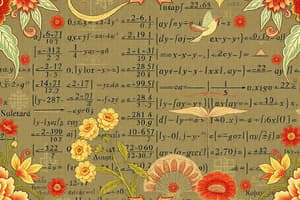Podcast
Questions and Answers
What is the result of simplifying the expression \(3a - 2b + 4a + 5b\)?
What is the result of simplifying the expression \(3a - 2b + 4a + 5b\)?
- 5a + 3b
- 7a + 7b
- 5a + 7b
- 7a + 3b (correct)
Expanding the expression \(3(x + y)^2\) results in:
Expanding the expression \(3(x + y)^2\) results in:
- 3x^2 + 3xy + y^2
- 3x^2 + 6xy + 3y^2
- 3x^2 + 6xy + 6y^2 (correct)
- 3x^2 + 6xy + 9y^2
In the expression \(4x + 2y - z = 3x + y - 4z\), after simplifying, what is obtained on one side of the equation?
In the expression \(4x + 2y - z = 3x + y - 4z\), after simplifying, what is obtained on one side of the equation?
- -2z
- x - 3z
- -x - z
- x - z (correct)
When factoring the expression \(x^2 - 9\), what is the correct factorization?
When factoring the expression \(x^2 - 9\), what is the correct factorization?
What is the simplified form of \(2(3x + y) - x(4 - x)\)?
What is the simplified form of \(2(3x + y) - x(4 - x)\)?
What is the correct expansion of \(a(b + c)^2\)?
What is the correct expansion of \(a(b + c)^2\)?
After evaluating the expression \(5(x-2)^2\), what is the result?
After evaluating the expression \(5(x-2)^2\), what is the result?
In the expression \(4a(a+b) - b(a-b)\), what is the correct simplified form?
In the expression \(4a(a+b) - b(a-b)\), what is the correct simplified form?
What is the expanded form of \(3(a+b)(a-b)\)?
What is the expanded form of \(3(a+b)(a-b)\)?
After simplifying \(6x - (4y - x)\), what is the correct form of the expression?
After simplifying \(6x - (4y - x)\), what is the correct form of the expression?
What is the result of expanding the expression \(a(x+y)^2\)?
What is the result of expanding the expression \(a(x+y)^2\)?
Flashcards are hidden until you start studying
Study Notes
Algebraic Expressions can seem daunting when you first encounter them because they often contain multiple variables, operations, and symbols that require careful manipulation before reaching their final value. However, with some basic knowledge of algebraic methods such as simplifying expressions, combining like terms, expanding expressions, factoring polynomials, and evaluating expressions, these challenges become much more manageable. Let's take a closer look at each of these techniques one by one.
Simplifying Expressions involves reducing complex expressions to simpler forms. For instance, if we have (5x + 9y - 7z - x = 6), we can rearrange this expression by collecting similar terms together, resulting in ((4x+9y) - z=6). Similarly, the product ([(x^2)^{2}]^{3}) reduces down to just (x^{8}), which is a simple power.
Combining Like Terms means grouping terms with the same variable raised to the same degree. So, in our example above, both (5x+x) are multiplied by the factor (5), leaving us with (5x+x=-z+6).
Expanding Expressions occurs when the factors inside parentheses need to be expanded into individual products. For example, (ab+(a+b)^2=(a+b)(a+b)), where the expression inside the second set of parentheses has been replaced by its expansion ((a+b)(a+b)=a^2+2ab+b^2).
Factoring Polynomials allows us to break up a polynomial into two or more terms times another term. As an illustration, let's consider (x^2-16x+64=(x-8)(x+8)). Here, (x^2-16x+64) expands out to agree with the result of multiplying ((x-8)(x+8)).
Evaluating Expressions requires finding specific values for variables within an equation, allowing us to determine what the output or answer will be. Consider (5n-3m+7p=5n-(3m)+7p). Substituting in different numbers for (n) or other letters gives us different results; substituting in (n=3,\ m=2,\ p=4) leads to (5(3)-3(2)+7(4)=15-6+28=47).
By understanding how to work with these various operations and constraints that form part of simplifying, combining, expanding, factoring, and evaluating expressions, you'll gain mastery over algebraic equations generally and make solving problems significantly easier!
Studying That Suits You
Use AI to generate personalized quizzes and flashcards to suit your learning preferences.




